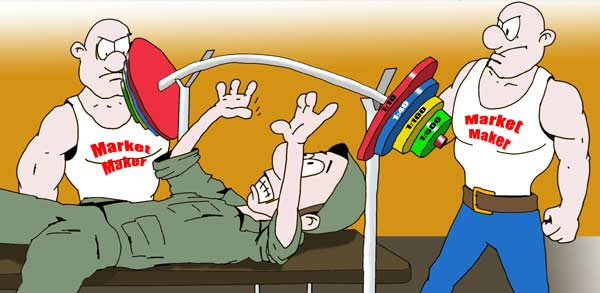Part II. Overleveraging and Transaction Costs


| Leverage | 2xBid/Ask Spread, Relative to Your Position | Bid/Ask Spread Paid as a Part of Your Capital, % |
|---|---|---|
| 1:1 | 4 pips = 0.0004 | 0.04% |
| 1:2 | 4 pips*2 = 0.0008 | 0.08% |
| 1:4 | 4 pips*4 = 0.0016 | 0.16% |
| 1:8 | 4 pips*8 = 0.0032 | 0.32% |
| 1:16 | 4 pips*16 = 0.0064 | 0.64% |
| 1:40 | 4 pips*40 = 0.0160 | 1.60% |
| 1:100 | 4 pips*100 = 0.04 | 4.00% |
| 1:500 | 4 pips*500 = 0.2 | 20.00% |
Pipruit: Wow, so, if we will totally utilize 1:500 leverage that is commonly provided now by different brokers, the bid/ask spread will be 1/5 of my start up assets. Say, if my capital 10,000 USD, then the bid/ask spread at any trade with 1:500 leverage will cost 2,000 USD?
But to give you just hard rocking foundation of that statement, let’s turn to some numerical examples. I know you like them, don't you?
Some examples
Commander in Pips: First, I would like to ask you create a table that shows how much your account value will change depending on price change %.
Pipruit: Well, I suppose we do not need even the table. For example, if leverage is 1:100, it means that if price will change for 1% our account value will change at 100%. That’s why it calls 1:100.
Pipruit: Margin shows the change of price in percents that will lead to 100% change in account value if leverage is totally utilized. As you’ve said margin is 5% and we apply leverage totally to our account value, i.e. use total account value as margin, then price should change for 5% to force the change in account value at 100%.
Let’s suppose that you’re newbie day trader and you apply just a 50 pip stop-loss in most of your trades. You’ve checked it by the market’s volatility and come to the conclusion that for intraday charts this stop is sufficient. You’ve opened mini account with 1000$.
TASK #1 – you have opened a couple of mini lots at EUR/USD with average stop at 35 pips. If your stop has been triggered by the price – what part of your assets you have lost?
Pipruit: Well, first we need to calculate the margin, I suppose:
- Two mini lots are 10,000x2 = 20,000. Hence my leverage is 1:20;
- 0.0035*20*100 = 7%!
What a surprise – I’ve lost 7% right at start-up trade, unbelievable. But this was just a bad day. Probably. I’m ready for a return match, but I want to not just return to breakeven, but also to make a profit. So, probably I need to enter with 4 mini lots now…
TASK #2 – you have opened four mini lots at EUR/USD with an average stop at 30 pips. But you’ve missed the time of a big US GDP release, so your stop has been triggered on fake out. What part of your assets you have now lost?
Pipruit: My assets after first trade are 1000-70 = $930.
Leverage = 4*10,000/930~43:1;
Loss = 0.0030*43*100 = 13%
Account balance now is 1 000-70-120 = 810$
Leverage = 4*10,000/930~43:1;
Loss = 0.0030*43*100 = 13%
Account balance now is 1 000-70-120 = 810$
Again, you’re newbie day trader and you apply just a 50 pip stop-loss in most of your trades. You’ve checked it by the market’s volatility and come to the conclusion that for intraday charts this stop is sufficient. You’ve opened mini account with 1000$.
TASK #3 – you have decided that this was just a fake out and thought that maybe you have to place farther stops. So, you’ve entered with the same 4 mini lots, but with 70 pip stops. Right at this moment an ECB rate hike has happened and you have been stopped out…
Pipruit: Ok, ok -
Leverage = 4*10,000/810~50:1;
Loss = 0.0070*50*100 = 35%
Account balance now is 810-70-120-280 = 460$
Pipruit: Yes, so – I intend to enter on 5 min chart with 10 lots – stop will be tight – 20 pips, since this is 5 min chart!
Pipruit: Oh, no…
Leverage = 10*10,000/460 ~217:1
Pipruit: Finally, I’m returning in Big business and my profit is…
Pipruit: 460 – 10*10,000/250 = 460-400 = $60.
Pipruit: Margin call… After just 6 pips against me… 6 pips!
Commander in Pips: That’s the cost of overleveraging and underestimation of it. Also pay attention to how “trader’s sins” go side-by-side with destroying of your trading plan. First, you just entered with slightly greater lot, later you totally have broken all money management and in last trade you have absolutely denied and negated your entire trading plan per se.
Pipruit: Right, sir. But in reality I hope that I will not fall into this pit. I will try to be a disciplined and diligent trader.
Commander in Pips: You’re one of my best pipruits. I hope so that you will be fine. Finally, at the end of the current chapter let’s just point out important moments of leverage and how to deal with it.
1. You have to 100% understand how leverage impacts on your assets value. So, this will let you to choose – when to use it and when not;
2. Very often leverage just blows off trading accounts due light attitude to it or simply ignorance of it. It is worthwhile to say that this is typical not just for newbie traders but sometimes even experienced ones have fallen into such traps;
3. The more you’re leveraged the more you have to be careful and disciplined;
4. Brokers provide you with huge leverage, since their money comes from the bid/ask spread and very often your loss also. Hence the more often you trade with big leverage and/or big loses – all the better for them. But don’t give them a chance – try to ride leverage with no-leverage trading initially with profit. Later you will able to use greater leverage in your favor reasonably;
5. Leverage is not a case of “Whatever is not forbidden is permitted”;
6. Again, trading is a business – this is not a “how to be richer than Mr. Buffet in 5 days” journey. So, treat it correspondingly with solid respect;
7. Reasonable goal setting will help you to not become fascinated by leveraging.
Comments
Table of Contents
- Introduction
- FOREX - What is it ?
- Why FOREX?
- The structure of the FOREX market
- Trading sessions
- Where does the money come from in FOREX?
- Different types of market analysis
- Chart types
- Support and Resistance
-
Candlesticks – what are they?
- Part I. Candlesticks – what are they?
- Part II. How to interpret different candlesticks?
- Part III. Simple but fundamental and important patterns
- Part IV. Single Candlestick Patterns
- Part V. Double Deuce – dual candlestick patterns
- Part VI. Triple candlestick patterns
- Part VII - Summary: Japanese Candlesticks and Patterns Sheet
-
Mysterious Fibonacci
- Part I. Mysterious Fibonacci
- Part II. Fibonacci Retracement
- Part III. Advanced talks on Fibonacci Retracement
- Part IV. Sometimes Mr. Fibonacci could fail...really
- Part V. Combination of Fibonacci levels with other lines
- Part VI. Combination of Fibonacci levels with candle patterns
- Part VII. Fibonacci Extensions
- Part VIII. Advanced view on Fibonacci Extensions
- Part IX. Using Fibonacci for placing orders
- Part X. Fibonacci Summary
-
Introduction to Moving Averages
- Part I. Introduction to Moving Averages
- Part II. Simple Moving Average
- Part III. Exponential Moving Average
- Part IV. Which one is better – EMA or SMA?
- Part V. Using Moving Averages. Displaced MA
- Part VI. Trading moving averages crossover
- Part VII. Dynamic support and resistance
- Part VIII. Summary of Moving Averages
-
Bollinger Bands
- Part I. Bollinger Bands
- Part II. Moving Average Convergence Divergence - MACD
- Part III. Parabolic SAR - Stop And Reversal
- Part IV. Stochastic
- Part V. Relative Strength Index
- Part VI. Detrended Oscillator and Momentum Indicator
- Part VII. Average Directional Move Index – ADX
- Part VIII. Indicators: Tightening All Together
- Leading and Lagging Indicators
- Basic chart patterns
- Pivot points – description and calculation
- Elliot Wave Theory
- Intro to Harmonic Patterns
- Divergence Intro
- Harmonic Approach to Recognizing a Trend Day
- Intro to Breakouts and Fakeouts
- Again about Fundamental Analysis
- Cross Pair – What the Beast is That?
- Multiple Time Frame Intro
- Market Sentiment and COT report
- Dealing with the News
- Let's Start with Carry
- Let’s Meet with Dollar Index
- Intermarket Analysis - Commodities
- Trading Plan Framework – Common Thoughts
- A Bit More About Personality
- Mechanical Trading System Intro
- Tracking Your Performance
- Risk Management Framework
- A Bit More About Leverage
- Why Do We Need Stop-Loss Orders?
- Scaling of Position
- Intramarket Correlations
- Some Talk About Brokers
- Forex Scam - Money Managers
- Graduation!